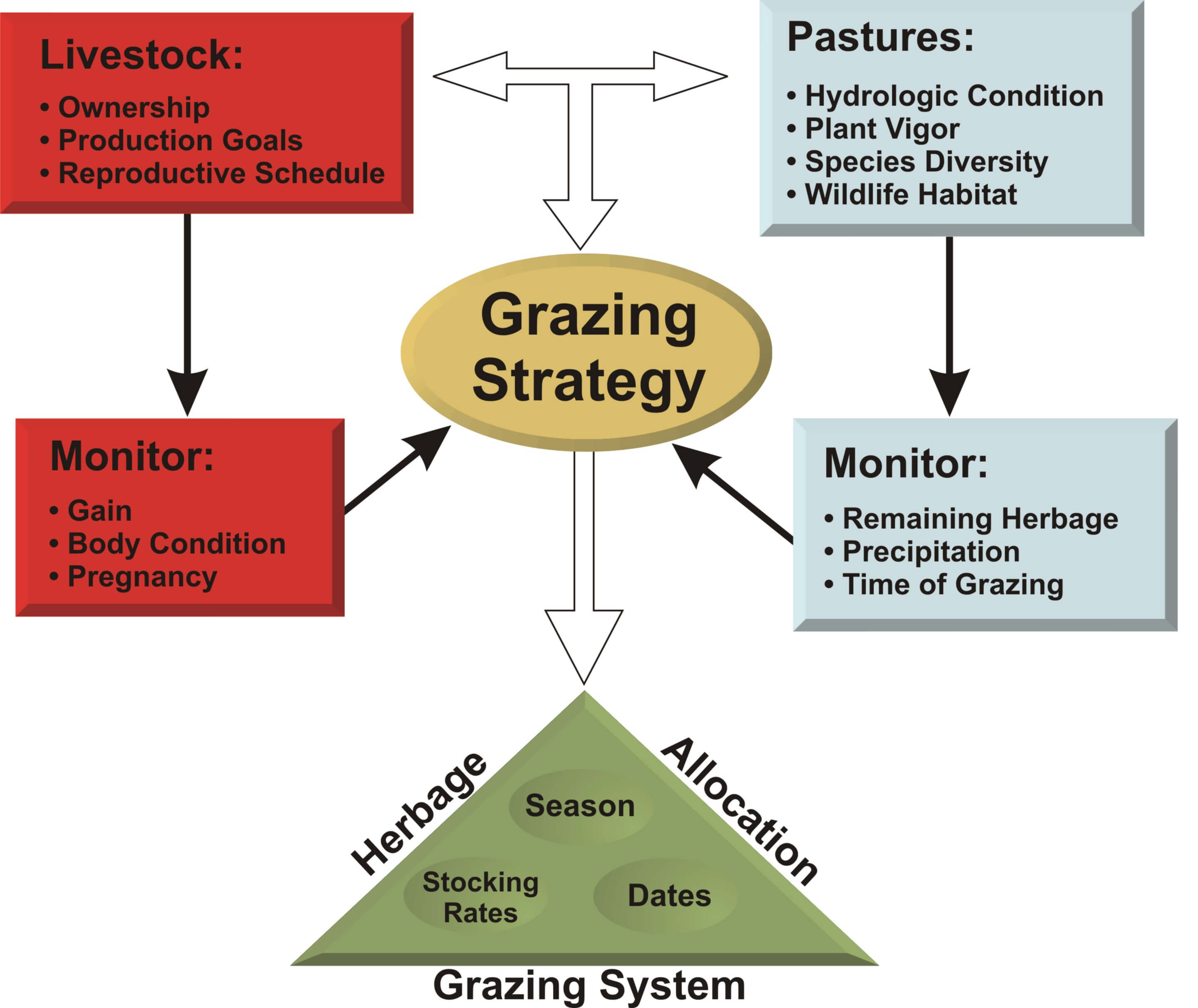Implementing a grazing strategy that increases vigor and abundance of desirable forage species and that improves hydrological condition of the range is one of the most effective ways you can prepare for drought.
Grazing Objectives
Decisions on when and where to graze should be based on clearly defined and prioritized animal-production and resource-management objectives.

Clearly stating and prioritizing your objectives will simplify your management decisions.
A grazing strategy is a plan for accomplishing a set of objectives, based on knowledge of available resources and the production and marketing environment.
Animal Production Objectives
Production objectives for growing livestock should be defined in terms of target weights at a future date that reflect future ownership and production plans.
Production per Acre vs. Individual Animal Performance
Maximizing yield of animal product per acre requires relatively high levels of ecological and economic risk. Higher stocking rates increase cumulative grazing pressure and increase the risk of damage to vegetation. Animal performance is less certain with high stocking rates, especially with variable precipitation. Inadequate plant cover increases runoff losses of precipitation and reduces soil water content.
Moderate stocking rates reduce ecological risks by leaving more herbage for ecosystem functions and increase the likelihood of optimizing net return per animal sold off grass.
Body Condition
Average body condition of breeding animals may also be a production goal of grazing strategies, especially when winter forages are limited to dormant, standing herbage on rangeland. It may reduce winter stress and cost less to winter dry cows on rangeland beginning with an average body condition score of 6.0 compared to a herd with an average score of 5.0 or less.
Weaning stops nutrient demands for lactation in most livestock and increases the rate at which body condition can be improved during the summer and fall. In contrast, if breeding animals are moved to relatively high quality crop residue after summer grazing, lower fall body condition may be acceptable.
Target animal condition scores at selected points during the annual reproductive schedule should be based on knowledge of seasonal patterns in nutritive value of available forage resources. Relatively low body condition scores may be acceptable during the second trimester of pregnancy if highly nutritious forage will be available during much of the third trimester as with summer calving herds.
Resource Management Objectives
 Grouse nest found on Fort Pierre National Grasslands. Image: SD Game Fish & Parks
Grouse nest found on Fort Pierre National Grasslands. Image: SD Game Fish & Parks
Decisions on when and how to use plant resources have profound effects on the success of grazing strategies.
Plant resources can be used for livestock production, wildlife habitat, or ecosystem functions such as hydrologic condition and site stability.
Efficient use of herbage and woody plant growth can be evaluated only when all management objectives related to plant resources are clearly understood.
For example, if a sustainable prairie-grouse population is one of the resource management objectives, uneven distribution of grazing may leave enough standing herbage in parts of pastures to provide adequate nesting cover. In contrast, if livestock production is the major objective, uniform grazing distribution becomes important.
Ecologically and economically efficient management depends on properly balancing total forage requirements of the herd with available forage resources on grazable land. Steep topography or heavy tree or shrub canopy, or excessive distances to livestock water are likely to reduce the grazable acres within ranches, allotments, or individual pastures.
Sample Management Objectives to Increase Drought Readiness
* Improve grazing distribution
* Maintain body condition score at average of "6" going into winter
* Time weaning to allow for marketable yearlings on grass that may be sold in case of drought
* Facilitate livestock management
* Improve range condition
* Increase vigor of preferred plant species
* Heal disturbed sites
* Provide nesting cover for grouse
Implementing a Grazing Strategy
Plant growth, livestock performance, and wildlife populations are affected by your grazing strategy, including stocking rate and the time of grazing.
Grazing systems define periods of grazing and non-grazing and are important tools for executing your grazing strategy. For more a description of various common grazing systems, see “Grazing Systems.”
When objectives and priorities change, the kind of grazing system most likely to accomplish the objectives may also change.